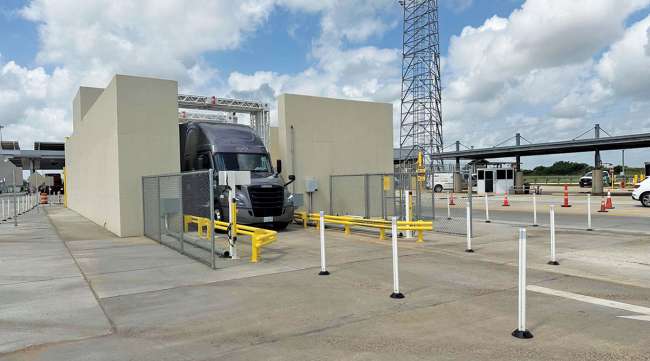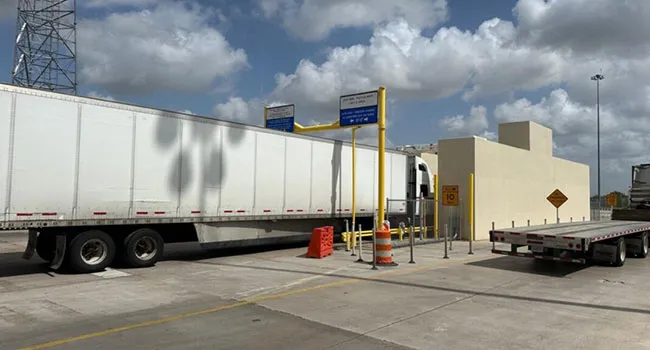Staff Reporter
CBP Installs X-Ray Scanner for Containers at Texas Port

[Stay on top of transportation news: Get TTNews in your inbox.]
The busiest land border crossing between the United States and Mexico is now equipped with an advanced X-ray machine that is intended to help more efficiently move commercial vehicle traffic through the facility by speeding up the pace for cargo inspections.
Called a Multi-Energy Portal, the technology was introduced at the Interstate 35 Border Patrol Checkpoint in Laredo, Texas, by U.S. Customs and Border Protection in early July. The system is capable of providing inspectors with multiview image capability for cargo examination, CPB said, and can scan more than 150 containers per hour.
The Laredo port of entry is the busiest land border crossing for commercial vehicles in the U.S., followed by Detroit; Otay Mesa, Calif.; and Buffalo/Niagara Falls, N.Y., according to the U.S. Bureau of Transportation Statistics. The Texas facility handled 2.43 million incoming trucks from Mexico during fiscal 2023, up 4.9% from 2022, and handles nearly 40% of all commercial truck traffic passing through the nation’s southern border. Year-to-date monthly crossings as of July 23 totaled 169,884, 3.1% higher than the same time last year, as tracked by the city of Laredo.
Most of the Laredo truck traffic is drayage and consists of short-distance shipments between warehouses in Laredo and Nuevo Laredo, Mexico, according to the Federal Highway Administration’s Freight Management and Operations unit. “Typically, long-distance trucks in either Mexico or the United States unload their cargoes at a warehouse, where it is transferred to a shorthaul truck for the trip across the border,” the agency said. “Other shipments move directly from a factory near the border in Mexico to a warehouse across the border in Texas or from a warehouse in Texas to a factory in Mexico. These shorthaul trucks usually make up to three trips a day across the border.”
RELATED: Cargo Processing in Texas Improved at Del Rio Land Port
A CBP spokesperson told Transport Topics, “CBP utilizes nonintrusive inspection [NII] systems to examine cargo and conveyances for illicit goods and substances. As a result, CBP is able to quickly make assessments on shipments without having to offload the commodities, which saves time and money for the importer and allows the shipments to move through in an expeditious manner. Due to law enforcement sensitivity, CBP does not elaborate on the timing or frequency of NII inspections, but the NII is an important tool in our arsenal to support the work of our frontline officers to interdict narcotics.”

The Laredo port of entry is the busiest land border crossing for commercial vehicles in the U.S. (U.S. Border Patrol Laredo Sector via Facebook)
Touting the MEP technology last year, Laredo Port Director Alberto Flores said, “The MEP portals will scan commodities arriving from Mexico. CBP officers will adjudicate the images and, in turn, detect contraband and similar security threats promptly. The goal of this newly implemented technology is to enhance border security all while facilitating the efficient flow of trade into the U.S.”

Lord
Brandon Lord, executive director of Trade Policy and Programs in the CBP’s Office of Trade, U.S. Customs and Border Protection, testified in May before a U.S. House of Representatives hearing that CBP processed more than 28.5 million imported cargo containers at all of the nation’s ports of entry in FY2023, processing 19,722 shipments. Among them, 23 million counterfeit products were seized. Most of these fake goods, with a total retail value of $2.78 billion, originated in China and Hong Kong. More than 2 million goods were counterfeit pharmaceuticals and personal care items “that threaten consumer safety,” Lord noted.
He added that CBP is continuously upgrading its facilities to provide agents with tools needed to efficiently process cargo.
“We are installing state-of-the-art scanning technology at our [ports of entry] and international mail facilities. The agency is also advancing our investments in artificial intelligence and automated tools to assist personnel in risk-assessment,” Lord said.
Want more news? Listen to today's daily briefing below or go here for more info:




